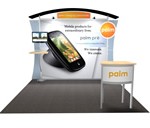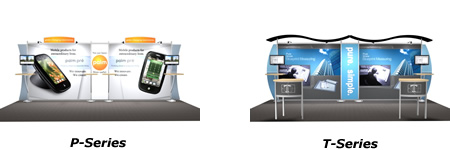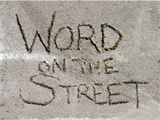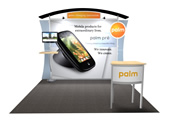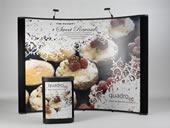I have been involved in the distributor/manufacturer relationship all my business life, except for a two-year stint in retail auto parts during college. In those two years, I learned that I don’t ever want to be in retail again. First of all, I love spending Saturday afternoons watching college football and basketball. Second, retail hours are insane, especially from Thanksgiving to Christmas.
For the last 24 years, I have been employed by manufacturers selling primarily to distributors. Currently, I serve as the National Sales Manager for Classic Exhibits and ClassicMODUL Aluminum Extrusions. My job takes me on the road . . . a lot. Typically, I travel anywhere from 30-50 percent of the time, often leaving on a Sunday afternoon and not returning until Friday evening. Over those years, working primarily in the trade show industry, I have literally spent years with distributors. I would hope that sitting in front of distributors and listening to them critique, complain, admonish, and praise manufacturers has given me a unique perspective. I may not build the exhibit or manage their projects, but I’m the guy who often takes the heat if something goes awry. It’s then that you learn, during those critical moments, what the distributor expects from the manufacturer — day after day, month after month, and (hopefully) year after year.
Honesty
Honesty seems to be a bit of a cliché’, but it is still the crux of every business relationship. From a distributor’s perspective, there’s one unbreakable rule that the manufacturer is never, ever allowed to break: DON’T sell direct to end users . . . EVER. It’s the kiss of death. As a manufacturer, if you have to stop and concoct a story to justify your actions for selling direct, then the damage is done and probably cannot be repaired. Both of my previous two employers, Classic Exhibits and Optima Graphics, do not sell direct. They respect the services and knowledge that distributors contribute and recognize that they, as a manufacturer, do not have the same skill sets.
Transparency
Honesty and transparency are slightly different. You expect your manufacturer to be honest, but you are surprised when your manufacturer is transparent. Transparency suggests the manufacturer views the distributor not merely as a customer but also as a partner. It implies their futures are intertwined and that by sharing information and knowledge that they are more likely to be successful together. At Classic, we pride ourselves on our transparency. If you ask us a question (with the exception of sales figures), we will answer it, whether it reveals our beauty marks or our age spots. To distributors, this simple open dialogue goes a long way towards creating a shared bond, a partnership.
 Innovation
Innovation
Distributors (exhibit sales offices in this case) want to be on the cutting edge. Years ago it was exclusivity. In today’s world, it is service, design, or sometimes price. Distributors expect manufacturers to react to market changes and to create new, exciting products or designs. Every sales person wants a reason to contact their customer. The easiest way, without a doubt, is to be able to say, “Hey, look at this cool new ‘widget’. You are going to LOVE this?” For those of you old enough to remember when a “pop up” was new, think of how people were awestruck with this newfangled “technology.” A distributor is always looking for that kind of WOW response from their clients.
One of the things I personally am grateful for about Classic Exhibits is that since I started with them, the company has added over 150 10 x 10 and 10 x 20 portable/modular hybrid designs starting under $9000. Now that is innovation!
Reaction
All of us are human. Manufacturer, Distributor, End user . . . we all have that one thing in common. We all make mistakes. How we react to those mistakes determines a great deal about your character. Many times the distributor is in the middle of a “situation.” Regardless of the who, what, why, or where something went wrong, the end user is unhappy and the distributor relies on the manufacturer for help. The very LAST thing a distributor wants to hear from their manufacturer are these few words. “There is no way that can happen.” I can promise you, that just created a great divide between all parties. That distributor wants to hear:
- You have a solution
- You are going to implement that solution quickly
- We are going to discuss this again after the end user/client is satisfied and make sure that we take the necessary steps to prevent it from happening again.
They do not want the finger pointed, they don’t want to assess blame and make mountains out of mole hills. They want a quick, effective resolution. If you want to maintain them as your distributor, you as a manufacturer, better provide that to your customer!
 Marketing/Leads
Marketing/Leads
One of the things that can be both frustrating and rewarding are leads from a manufacturer. In the past, a distributor would get leads passed on from their supplier/manufacturer by the dozens. Most of them were pretty worthless. A person on a flight checks all the advertisements in an in-flight magazine and tons of resources are wasted on something that was filled out by an 11 year old. Worthless leads drive a distributor crazy. There is not a “one size fits all” plan since a market like Birmingham is totally different from Boston or San Francisco.
In today’s world, distributors expect a manufacturer to help them market by giving them the tools necessary to reach their client base and beyond. They expect leads from trade shows because they ARE quality leads most of the time.
In addition, they expect marketing support – such as custom branded literature or websites. These tools put marketing back in each distributor’s capable hands to modify to their market and their corporate image. They want autonomy and will go to great lengths to get it. Exhibit Design Search is a terrific example. It’s a comprehensive exhibit design search and communication tool customized for each distributor’s website. No one distributor could create and maintain it. But collectively, it allows everyone to benefit with minimum expense and time commitment.
I am positive there are things I haven’t touched on here, but from my experience, if you follow these basics, you are far more likely to have happy and successful long-term customers/distributors.
Till the next time,
–Reid Sherwood
reid@classicmodul.com





